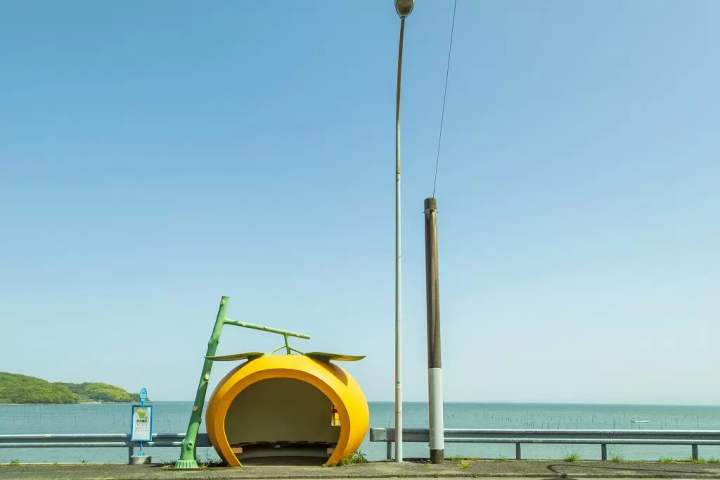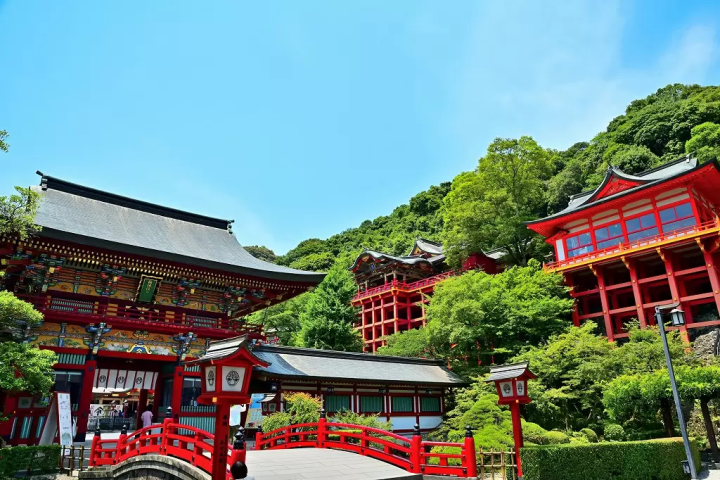Nagasaki's Fruit-Shaped Bus Stops: Map, Access, and Travel Tips

The quaint seaside town of Konagai, just an hour's drive from Nagasaki City, is home to 16 colorful fruit bus stops! Popular in recent years among photographers and content creators, these fruit-shaped bus stops and their incredible scenery offer a one-of-a-kind experience.
The Fruit Bus Stops in Nagasaki: Access and Information
1. Tokimeki Fruit-Shaped Bus Stop Avenue
2. Map of the Fruit-Shaped Bus Stops
3. How to Access the Fruit-Shaped Bus Stops by Car and Bus
4. Great Places to Visit Nearby
Read also
Tokimeki Fruit-Shaped Bus Stop Avenue

Photo by Pixta
Along the picturesque coastline of Konagai in Nagasaki, there lies a hidden treasure that enchants all who venture here: 16 gigantic, colorful fruit-shaped bus stops!
Dotted along National Route 207, these delightful bus stops were created ahead of the Journey Exposition Nagasaki 1990 and were designed to offer a sweet escape for travelers exploring this captivating region.

Photo by Pixta
Said to be inspired by Cinderella's pumpkin carriage, these 16 adorable fruit bus stops have become a sensation among travelers and photographers alike, due to this they have become a permanent installation in this charming seaside town!
Visitors to Konagai can embark on a delightful quest to spot five different types of fruits along their journey: strawberries, oranges, tomatoes, watermelons, and cantaloupes.

Photo by Pixta
Due to the mesmerizing scenery of this region, explorers are rewarded with stunning sights that look like scenes straight from a Studio Ghibli movie!

Photo by Pixta
From strawberry and cantaloupe bus stops surrounded by cosmos and sunflower fields in September to vibrant orange stops framed by the sparkling ocean stretching out into the distance, you can capture amazing photos here.
Fruit-Shaped Bus Stops: Location and Map
The town of Konagai is located approximately halfway between Nagasaki City and Saga City along Highway 207. It takes about an hour by car to reach it from either of these cities, making it a great addition to your Kyushu itinerary!
How to Access the Fruit-Shaped Bus Stops by Car and Bus
To visit the fruit bus stops, you can either rent a car or take the train and bus.
For those opting to drive around Kyushu Island, you are in for a treat—many hidden gems, such as the fruit bus stops, can be easily accessed by car, giving you a whole new experience and perspective on this beautiful island.
Access by Car
To reach the bus stops by car, we recommend driving from Nagasaki City along National Route 207—a highway that connects Saga City to Nagasaki City and beyond!
Along the way, you can spot the fruit bus stops while enjoying the amazing scenery.
If you’d like to get out of the car and explore on foot, we suggest finding a parking spot along the route, such as the car park located next to the Strawberry bus stop.
Please note that the fruit bus stops are widely dispersed along the road, taking approximately nine minutes by car or around one hour and thirty minutes on foot from start to finish.
Alternatively, those traveling by bike can enjoy a scenic ride from start to finish and then take a bus back to where their car is parked!
Read also
Access by Train and Bus
If you travel by train, take the local Isahaya train on the JR Nagasaki Line from Nagasaki Station to Isahaya Station.
From there, transfer to the local Hizen-Hama train and stop at Nagasato Station. Upon arrival, walk to the Tonosaki Bus Stop where you will find the first fruit bus stop: a watermelon!
From here, take the bus bound for Kenkai-Nishisahaya Station (県界-西諫早駅県界行) and get off at the fruit-shaped bus stops along the way until reaching the Amidazaki bus stop (阿弥陀崎).
Alternatively, you can take the train to Konagai Station and walk for about 15 minutes to see the strawberry and melon bus stops highlighted in the cover photo.
The Amidazaki bus stop offers iconic fruits, including a beautiful orange against an ocean backdrop, while Izaki features strawberry and melon bus stops.
Please note that buses may not run frequently, so it's essential to plan your trip accordingly!
↑ Return to the top of article.
Great Places to Visit Nearby
In this section of the article, we introduce five beautiful spots that you can add to your itinerary when visiting Konagai, making the most of your time and trip!
1. The Floating Torii Gate of Oouo Shrine

Photo by Pixta
Around a 20-minute drive north, or a 30-minute train ride from Konagai Station, lies the Floating Torii Gate of Oouo Shrine, an enchanting spiritual site steeped in ancient legend.
Gaining its name from Oouo Shrine, meaning Great Fish Shrine in Japanese, the site is associated with a legend that tells the tale of an unpopular and cruel governor who was tricked by the local townspeople and left drunk on Okinoshima Island, only to be rescued by a gigantic fish that took him back to the mainland.
Facing the Ariake Sea, these three brilliant red torii gates create an infinite pathway into the ocean, peacefully floating among the waves. Depending on the tide, visitors can walk out to sea under the gates or witness them in their full beauty surrounded by waves, creating a captivating scene that looks like it is straight out of a Ghibli movie!
↑ Return to the top of article.
2. Yutoku Inari Shrine

Photo by Pixta
Approximately 30 minutes north by car or an hour by train and bus lies the enchanting Yutoku Inari Shrine, located in Kashima City, Saga Prefecture.
This shrine is renowned as one of Japan's three most famous shrines dedicated to Inari, the deity of harvest, drawing around 3 million visitors annually.
Nestled within the beautiful mountainscape of Saga, Yutoku Inari Shrine is perched on natural cliffs, offering breathtaking views of dense forests and rolling hills. Its striking wooden red beams and vibrant torii gates stand out magnificently against the lush greenery.
Visitors can wander along cobbled pathways that ascend the hill, culminating in stunning vistas of the Ariake Sea and local cityscapes.
Established in 1706, the shrine is a well-preserved historical site. It hosts various popular events throughout the year, showcasing seasonal flowers, such as azaleas in Higashiyama Park, alongside serene Japanese gardens and the Yutoku Museum.
Read also
↑ Return to the top of article.
3. Mifuneyama Rakuen in Takeo Onsen

Photo by Pixta
Around 50 minutes north by car from Konagai, or a two-hour train ride, lies the enchanting Mifuneyama Rakuen—a breathtaking destination that seamlessly blends nature with art.
Known for its stunning landscapes and rich history, Mifuneyama invites visitors to immerse themselves in the beauty of the Japanese countryside along with unique cultural experiences.
Taking the spotlight is Mifuneyama Rakuen, a historical Japanese garden renowned for its serene beauty and seasonal flowers, like azaleas. Visitors can stroll through meticulously landscaped grounds featuring picturesque ponds, vibrant blossoms, and majestic willow trees, offering a tranquil escape.

Photo by Prtimes
At night, the garden is illuminated by teamLab’s captivating exhibition, A Forest Where Gods Live. This immersive experience invites guests to explore a mesmerizing world of interactive digital art.
Onsite are dazzling indoor exhibitions such as a tea house adorned with floating lanterns and bathhouse ruins featuring an ecosystem of animals and flowers that dance across the bathhouse and gigantic megalith sculptures erupting from the earth.
Read also
4. Nagasaki City

Photo by Pixta
Nagasaki is just one hour south by car from Konagai. Renowned for its rich history and stunning sights, Nagasaki offers a unique blend of Japanese and international cultures. Visitors can immerse themselves in beautiful architecture, delicious cuisine, and vibrant activities.
Key attractions include Glover Garden, an open-air museum featuring Western-style mansions from the late 19th century, and Nagasaki Peace Park, which honors the victims of the atomic bomb during World War II. Mount Inasa offers award-winning night views, while Nagasaki Shinchi Chinatown delights with a variety of delicious dishes.
One must-try local specialty is champon, a flavorful noodle dish made with fresh ingredients. As you explore the bustling streets of Chinatown, indulge in various delicacies and shop for unique souvenirs, making your visit to Nagasaki a memorable experience filled with culture and culinary delights.
5. Unzen National Park

Photo by Pixta
Great for those with a car, Unzen National Park is approximately 30 minutes from Konagai Station and boasts a plethora of stunning scenery, hot springs, and nature!
Renowned for its smoldering hot springs and rocky landscapes, this natural park spans approximately 1,500 square kilometers. Created by the forces of nature, this landscape cherished by hiking and onsen enthusiasts has been shaped by multiple volcanic eruptions throughout history, the most recent occurring in 1990.
A site of historical significance due to its use as a place of harsh punishment for political prisoners during the 18th and 19th centuries, the area not only offers incredible scenery but also has a unique and intriguing past. Visitors who explore this region can expect to enjoy a range of remarkable hot springs, breathtaking nature, and much more!
Enjoy Exploring Nagasaki's Fruit-Shaped Bus Stops
The fruit-shaped bus stops in Konagai are like no other! Located amongst stunning nature and along the way to beautiful areas in the region, they are easy to access when traveling around Nagasaki and Saga.
Why not visit Konagai and indulge in a photo session with these utterly adorable bus stops? Nagasaki is full of incredible spots, nature, and history so a visit to this region is a must!
Read also
Main image by Pixta
Assistant editor at MATCHA since 2023, Kate is a photographer who enjoys traveling Japan's hidden gems and adventuring off the beaten path. Living in Japan since 2018, she has traveled across different areas of Japan. From indulging in Aomori’s apple pies and fiery festivals to exploring the quaint charm of Nagasaki’s cat-filled streets she is always searching for new areas full of atmospheric beauty, festivals, and seasonal events to capture on camera.













































![[2026] Top 5 Strawberry Picking Spots in Tokushima, Naruto| Farms and Access Guide for January to May](https://resources.matcha-jp.com/resize/720x2000/2025/03/06-227165.webp)

